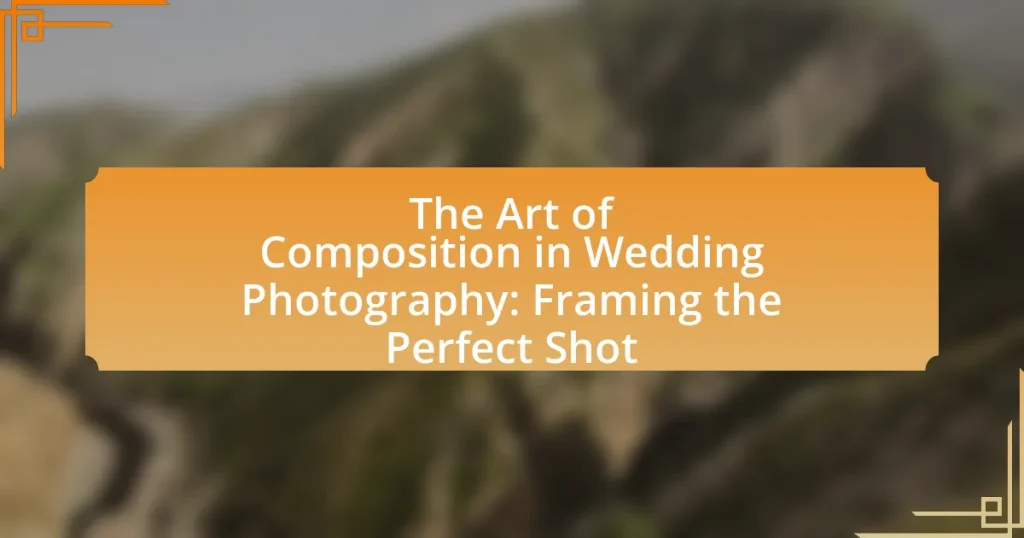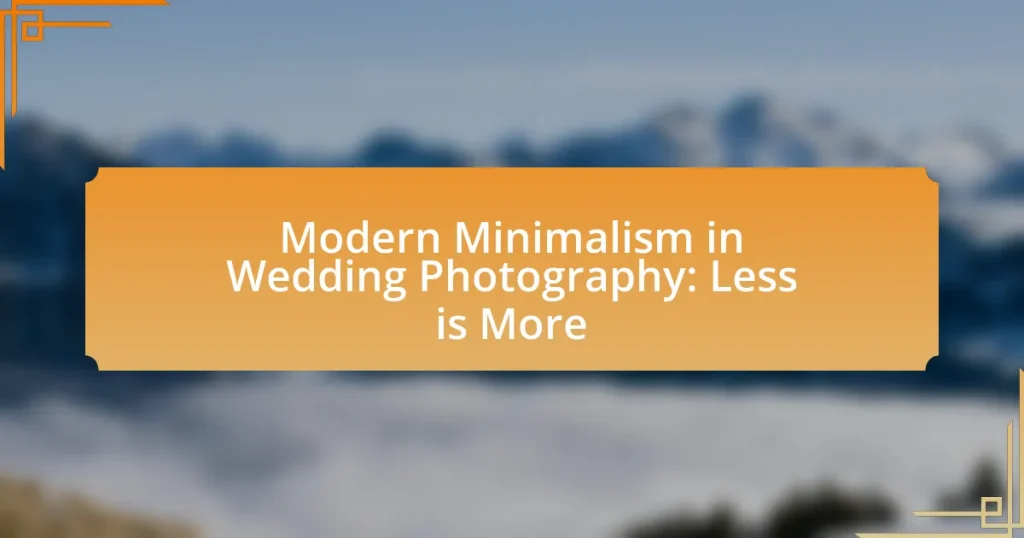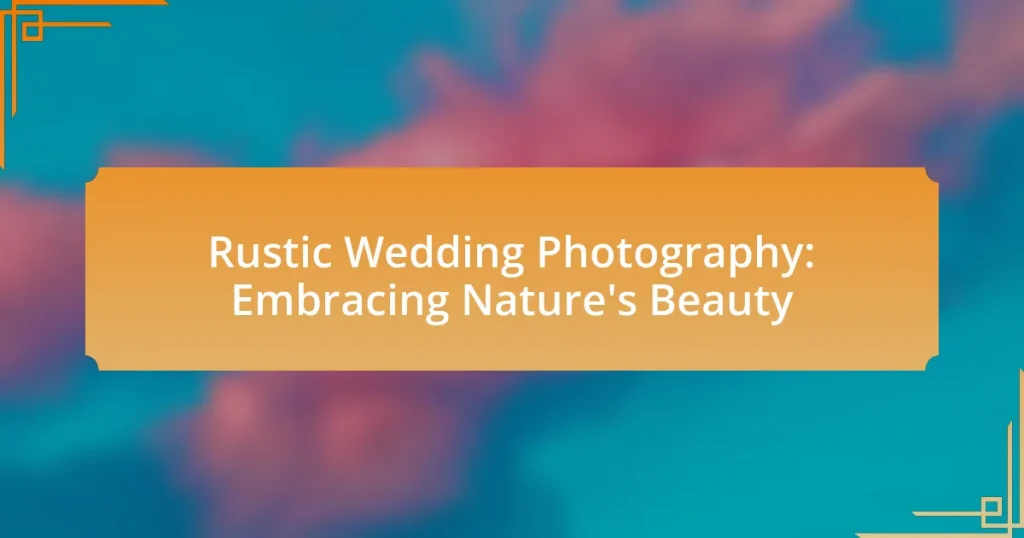The article focuses on “The Art of Composition in Wedding Photography,” emphasizing the importance of effectively arranging visual elements to create emotionally impactful images. It outlines key compositional techniques such as the rule of thirds, leading lines, framing, symmetry, and depth, which enhance storytelling and emotional resonance in wedding photography. Additionally, the article discusses how composition influences viewer engagement, the significance of adapting techniques to various wedding settings, and practical tips for mastering these skills. By understanding and applying these principles, photographers can capture memorable moments that resonate with couples and their families.
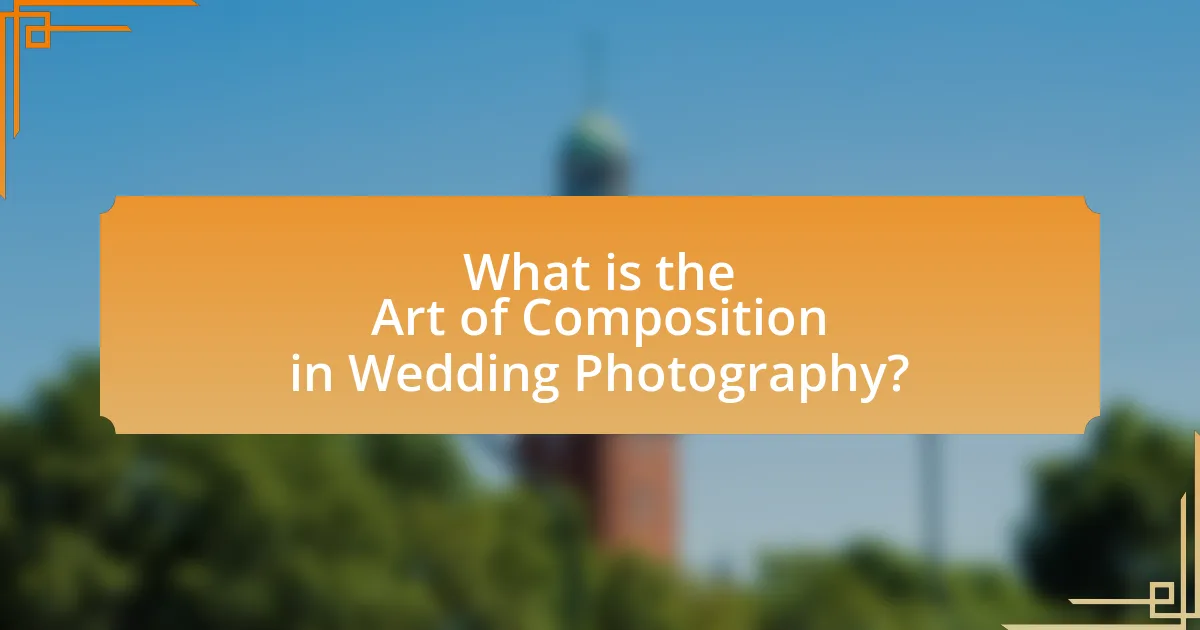
What is the Art of Composition in Wedding Photography?
The Art of Composition in Wedding Photography involves the strategic arrangement of visual elements within a frame to create aesthetically pleasing and emotionally resonant images. This technique emphasizes principles such as balance, symmetry, leading lines, and the rule of thirds, which guide the viewer’s eye and enhance storytelling. Effective composition can significantly impact the emotional response to a photograph, as evidenced by studies showing that well-composed images are more likely to evoke feelings of joy and nostalgia, essential in capturing the essence of a wedding day.
How does composition influence wedding photography?
Composition significantly influences wedding photography by determining how elements within a frame interact to create visual storytelling. Effective composition guides the viewer’s eye, emphasizes key moments, and enhances emotional impact. Techniques such as the rule of thirds, leading lines, and framing can transform ordinary scenes into compelling images, making the couple and their surroundings more engaging. For instance, a study by the American Society of Media Photographers highlights that well-composed images are more likely to evoke emotional responses, underscoring the importance of composition in capturing the essence of the wedding day.
What are the key elements of composition in photography?
The key elements of composition in photography include the rule of thirds, leading lines, framing, symmetry, and depth. The rule of thirds involves dividing the image into a 3×3 grid and placing subjects along these lines or at their intersections to create balance. Leading lines guide the viewer’s eye through the image, enhancing depth and perspective. Framing uses elements within the scene to create a ‘frame’ around the subject, drawing attention to it. Symmetry provides a sense of harmony and order, while depth can be achieved through layering elements in the foreground, middle ground, and background, adding dimension to the photograph. These elements are foundational in creating visually compelling images, as supported by principles established in photography education and practice.
How does composition affect the storytelling aspect of wedding photography?
Composition significantly influences the storytelling aspect of wedding photography by guiding the viewer’s eye and emphasizing key moments. Effective composition techniques, such as the rule of thirds, leading lines, and framing, help to create a narrative flow that captures the emotions and relationships of the subjects. For instance, placing the couple off-center can evoke a sense of intimacy and connection to their surroundings, while using leading lines can draw attention to significant interactions, such as a first kiss or a shared glance. These compositional choices not only enhance the visual appeal but also convey the story of the day, allowing viewers to engage with the emotions and experiences captured in each photograph.
Why is composition important for capturing memorable wedding moments?
Composition is crucial for capturing memorable wedding moments because it determines how elements within a frame interact to convey emotion and narrative. Effective composition guides the viewer’s eye, highlights key subjects, and creates a sense of balance and harmony in the image. For instance, the rule of thirds can enhance visual interest by positioning the couple off-center, drawing attention to their expressions and surroundings. Studies in photography emphasize that well-composed images evoke stronger emotional responses, making them more memorable for couples and their families.
How does composition enhance emotional impact in wedding photos?
Composition enhances emotional impact in wedding photos by guiding the viewer’s eye and emphasizing key moments and emotions. Effective use of elements such as framing, balance, and leading lines directs attention to the subjects, often highlighting the couple’s expressions and interactions. For instance, placing the couple off-center can create a sense of intimacy and connection, while including surrounding elements can evoke the atmosphere of the event. Studies in visual perception indicate that well-composed images are more likely to elicit emotional responses, as they resonate with viewers on a deeper level, making the captured moments feel more poignant and memorable.
What role does composition play in creating visual harmony?
Composition is essential in creating visual harmony as it organizes elements within a frame to achieve balance and unity. Effective composition guides the viewer’s eye, ensuring that all components of the image work together cohesively. Techniques such as the rule of thirds, leading lines, and symmetry contribute to this harmony by establishing relationships between subjects and their surroundings. Research in visual perception indicates that well-composed images are more likely to evoke positive emotional responses, reinforcing the importance of composition in visual storytelling, particularly in wedding photography where capturing the essence of the moment is crucial.
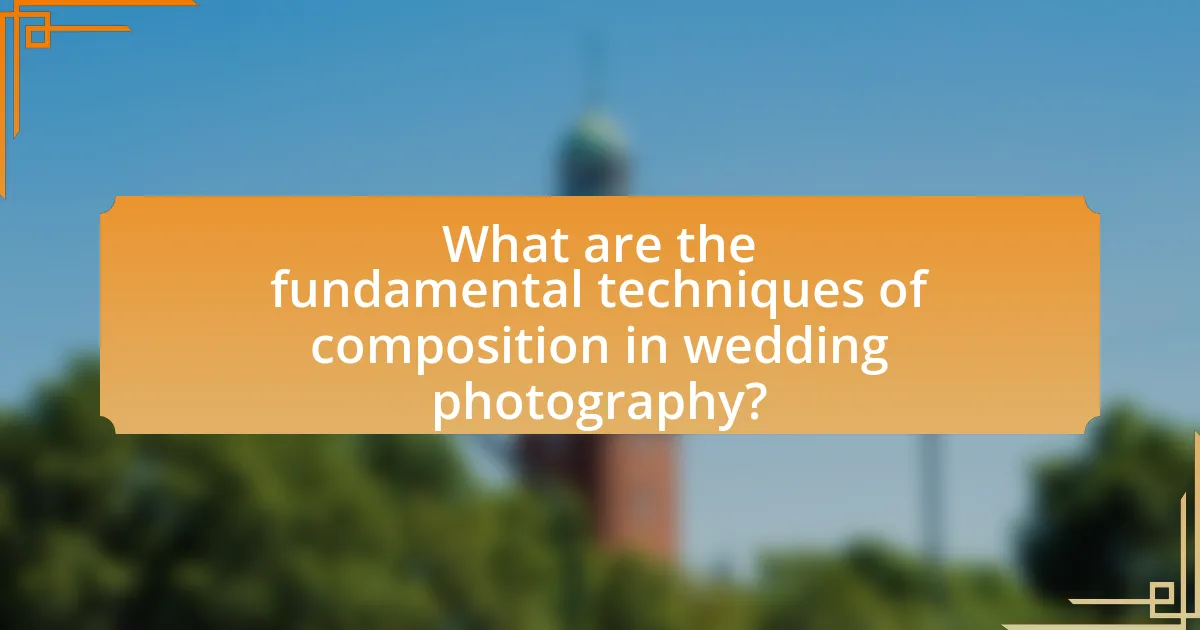
What are the fundamental techniques of composition in wedding photography?
The fundamental techniques of composition in wedding photography include the rule of thirds, leading lines, framing, symmetry, and depth. The rule of thirds involves dividing the frame into a grid and placing key elements along these lines or at their intersections to create balance and interest. Leading lines guide the viewer’s eye toward the subject, enhancing the visual flow of the image. Framing uses elements within the scene to create a ‘frame’ around the subject, drawing attention to it. Symmetry creates a sense of harmony and balance, often used in architectural shots or group portraits. Depth adds dimension to images by incorporating foreground, middle ground, and background elements, making the scene more engaging. These techniques are widely recognized in photography literature, such as “The Photographer’s Eye” by Michael Freeman, which emphasizes their importance in creating compelling compositions.
How can the rule of thirds be applied in wedding photography?
The rule of thirds can be applied in wedding photography by positioning key elements along the intersecting lines or at the points where these lines meet. This technique enhances visual interest and balance in the composition, guiding the viewer’s eye towards important subjects such as the couple or significant details of the event. For instance, placing the bride and groom at one of the intersections can create a more dynamic and engaging image compared to centering them. Studies in visual perception indicate that images aligned with the rule of thirds are often perceived as more aesthetically pleasing, which supports its effectiveness in wedding photography.
What are examples of effective use of the rule of thirds in wedding shots?
Effective use of the rule of thirds in wedding shots includes positioning the couple at one of the intersecting points while capturing the background elements, such as a scenic venue or floral arrangements, along the grid lines. For instance, placing the bride and groom off-center allows for a more dynamic composition, drawing the viewer’s eye across the image. Additionally, framing the wedding cake or bouquet using the rule of thirds can enhance visual interest, as these elements can be aligned with the grid lines to create balance and focus. This technique is widely recognized in photography as it helps to create more engaging and aesthetically pleasing images, making the subjects stand out against their surroundings.
How does the rule of thirds guide the viewer’s eye in wedding images?
The rule of thirds guides the viewer’s eye in wedding images by positioning key elements along imaginary lines that divide the frame into thirds, both horizontally and vertically. This compositional technique creates balance and draws attention to focal points, such as the couple or significant details, enhancing visual interest. Studies in photography indicate that images aligned with the rule of thirds are more engaging, as they encourage the viewer to explore the entire scene rather than fixating on a central subject. By strategically placing subjects at the intersections of these lines, photographers can lead the viewer’s gaze naturally through the image, resulting in a more dynamic and aesthetically pleasing composition.
What is the significance of leading lines in wedding photography?
Leading lines in wedding photography are significant because they guide the viewer’s eye towards the main subject, enhancing the composition and storytelling of the image. By creating a visual pathway, leading lines can draw attention to the couple or important elements in the scene, making the photograph more engaging. Research in visual perception indicates that lines naturally attract attention, which is why photographers often utilize architectural features, pathways, or natural elements to create these lines. This technique not only improves the aesthetic quality of the image but also helps convey emotions and narratives, making the captured moments more impactful.
How can leading lines direct attention to the couple in wedding photos?
Leading lines in wedding photos effectively direct attention to the couple by guiding the viewer’s eye towards them through compositional elements. These lines can be natural, such as pathways, fences, or architectural features, or they can be created through the arrangement of other subjects in the frame. By strategically placing these lines, photographers create a visual pathway that draws focus to the couple, enhancing their prominence in the image. Research in visual perception indicates that leading lines are a fundamental aspect of composition, as they exploit the human tendency to follow lines and shapes, thereby reinforcing the couple’s significance in the photograph.
What are some creative ways to incorporate leading lines in wedding compositions?
Incorporating leading lines in wedding compositions can enhance visual storytelling by guiding the viewer’s eye toward the couple or focal point. One effective method is to use natural elements like pathways, roads, or fences that lead directly to the subjects, creating a sense of depth and perspective. Additionally, architectural features such as arches, doorways, or windows can serve as leading lines, framing the couple and drawing attention to them.
Another creative approach is to utilize the arrangement of guests or floral arrangements to form lines that direct focus toward the bride and groom. For instance, positioning guests in a semi-circle can create a natural line leading to the couple during the ceremony.
Moreover, incorporating props like ribbons or streamers can also create dynamic leading lines, especially during action shots like the couple’s exit. These techniques not only enhance the composition but also add emotional context to the images, making them more engaging and memorable.

How can photographers adapt composition techniques for different wedding settings?
Photographers can adapt composition techniques for different wedding settings by assessing the environment and utilizing elements such as lighting, architecture, and natural surroundings to enhance their shots. For instance, in an outdoor setting, photographers can use natural light and landscape features to create depth and interest, while in a church or indoor venue, they may focus on symmetry and leading lines to highlight architectural details. Additionally, understanding the couple’s preferences and the wedding theme allows photographers to tailor their composition style, ensuring that the images resonate with the couple’s vision. This adaptability is crucial, as different settings present unique challenges and opportunities that can significantly impact the final images.
What challenges do photographers face in outdoor wedding settings?
Photographers face several challenges in outdoor wedding settings, primarily related to lighting, weather conditions, and environmental distractions. Lighting can be unpredictable, with harsh sunlight causing overexposure or deep shadows, making it difficult to achieve balanced exposure in images. Weather conditions, such as rain or wind, can disrupt planned shots and require photographers to adapt quickly to changing circumstances. Additionally, environmental distractions, including guests moving in and out of the frame or unwanted background elements, can complicate composition and focus. These factors necessitate a high level of skill and adaptability from photographers to capture the perfect shot in outdoor settings.
How can natural light be utilized to enhance composition outdoors?
Natural light can be utilized to enhance composition outdoors by strategically positioning subjects to take advantage of the quality and direction of sunlight. For instance, during the golden hour, which occurs shortly after sunrise and before sunset, the soft, warm light creates flattering shadows and highlights that improve the overall aesthetic of wedding photographs. This phenomenon is supported by the fact that natural light during these times reduces harsh contrasts and enhances skin tones, making subjects appear more vibrant and appealing. Additionally, using natural light to backlight subjects can create a halo effect, adding depth and dimension to the composition.
What composition strategies work best in outdoor environments?
Effective composition strategies in outdoor environments include the use of natural framing, leading lines, and the rule of thirds. Natural framing involves utilizing elements like trees or arches to create a border around the subject, enhancing focus. Leading lines guide the viewer’s eye toward the main subject, often using paths or rivers to draw attention. The rule of thirds suggests dividing the frame into a grid and placing key elements along these lines or at their intersections, which creates a balanced and engaging image. These strategies are supported by the principles of visual perception, which indicate that well-composed images are more likely to capture attention and convey emotion effectively.
How does indoor lighting affect composition in wedding photography?
Indoor lighting significantly influences composition in wedding photography by affecting the mood, color balance, and visibility of subjects. The quality and direction of indoor light can create shadows or highlights that enhance or detract from the overall image. For instance, soft, diffused lighting can produce flattering portraits, while harsh, direct light may result in unflattering shadows. Additionally, the color temperature of indoor lighting, such as warm tungsten bulbs versus cool fluorescent lights, can alter the color palette of the photographs, impacting the emotional tone of the images. Studies in photography emphasize that understanding and manipulating indoor lighting is crucial for achieving desired compositional effects, as it directly affects how elements within the frame interact visually.
What techniques can be used to manage low-light situations indoors?
To manage low-light situations indoors, photographers can utilize techniques such as increasing the ISO setting on their camera, using a wider aperture, and employing slower shutter speeds. Increasing the ISO enhances the camera’s sensitivity to light, allowing for better exposure in dim conditions. A wider aperture (lower f-stop number) permits more light to enter the lens, which is crucial for capturing details in low-light environments. Additionally, using slower shutter speeds can help gather more light, although this may require stabilization methods like tripods to avoid motion blur. These techniques are widely recognized in photography, as they directly address the challenges posed by insufficient lighting, enabling photographers to achieve clearer and more vibrant images even in challenging conditions.
How can photographers creatively use indoor elements to enhance composition?
Photographers can creatively use indoor elements such as furniture, lighting, and architectural features to enhance composition by incorporating them as framing devices or focal points. For instance, using doorways or windows can create natural frames that draw attention to the subject, while strategically placed furniture can lead the viewer’s eye through the image. Additionally, utilizing ambient lighting, such as soft lamps or candles, can add warmth and depth, enhancing the overall mood of the photograph. Studies in visual perception indicate that well-composed images with clear focal points and balanced elements are more engaging, supporting the effectiveness of these techniques in wedding photography.
What are some practical tips for mastering composition in wedding photography?
To master composition in wedding photography, photographers should focus on the rule of thirds, leading lines, and framing. The rule of thirds involves dividing the frame into a 3×3 grid and placing key subjects along these lines or at their intersections, which enhances visual interest. Leading lines guide the viewer’s eye toward the main subject, creating depth and context; for example, using pathways or architectural elements can effectively draw attention to the couple. Framing involves using elements in the environment, such as trees or arches, to create a natural border around the subjects, adding focus and context to the image. These techniques are widely recognized in photography as essential for creating compelling and balanced compositions.
How can photographers practice composition techniques before the wedding day?
Photographers can practice composition techniques before the wedding day by engaging in various exercises that enhance their skills. One effective method is to conduct photo walks, where photographers can experiment with different framing, angles, and lighting in diverse environments. This practice allows them to apply principles such as the rule of thirds and leading lines in real-time scenarios. Additionally, reviewing and analyzing their previous work helps photographers identify strengths and areas for improvement in composition. Studies show that consistent practice and critique lead to improved photographic skills, as evidenced by the findings in “The Role of Practice in Skill Acquisition” by Ericsson et al., which emphasizes the importance of deliberate practice in mastering complex skills.
What common mistakes should photographers avoid in wedding composition?
Photographers should avoid common mistakes such as poor framing, distracting backgrounds, and neglecting the rule of thirds in wedding composition. Poor framing can lead to important subjects being cut off or placed awkwardly within the image, which detracts from the overall impact. Distracting backgrounds can draw attention away from the couple, making it essential to choose locations that enhance rather than detract from the subject. Additionally, neglecting the rule of thirds can result in static and unengaging images; positioning key elements along these lines or at their intersections creates a more dynamic composition. These mistakes can significantly diminish the quality of wedding photographs, emphasizing the importance of careful composition.
